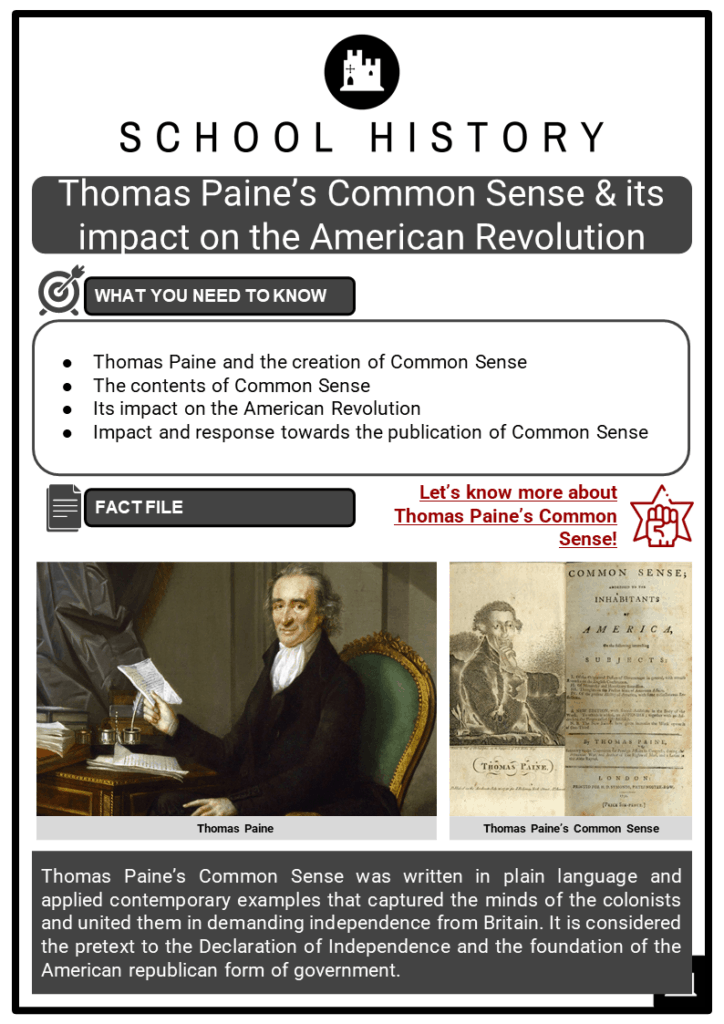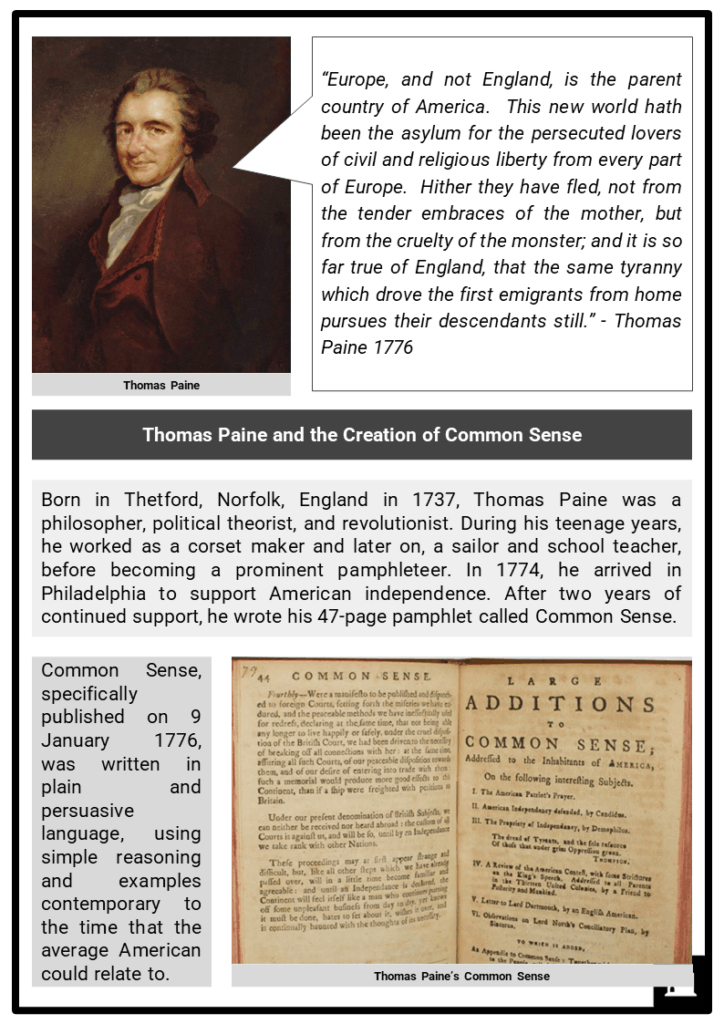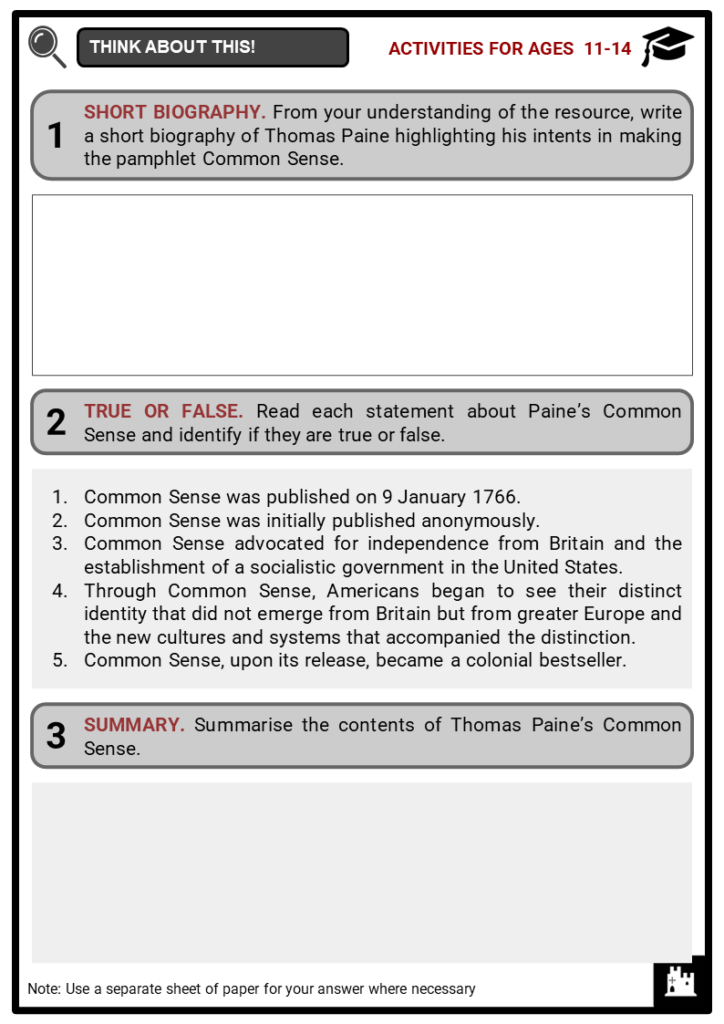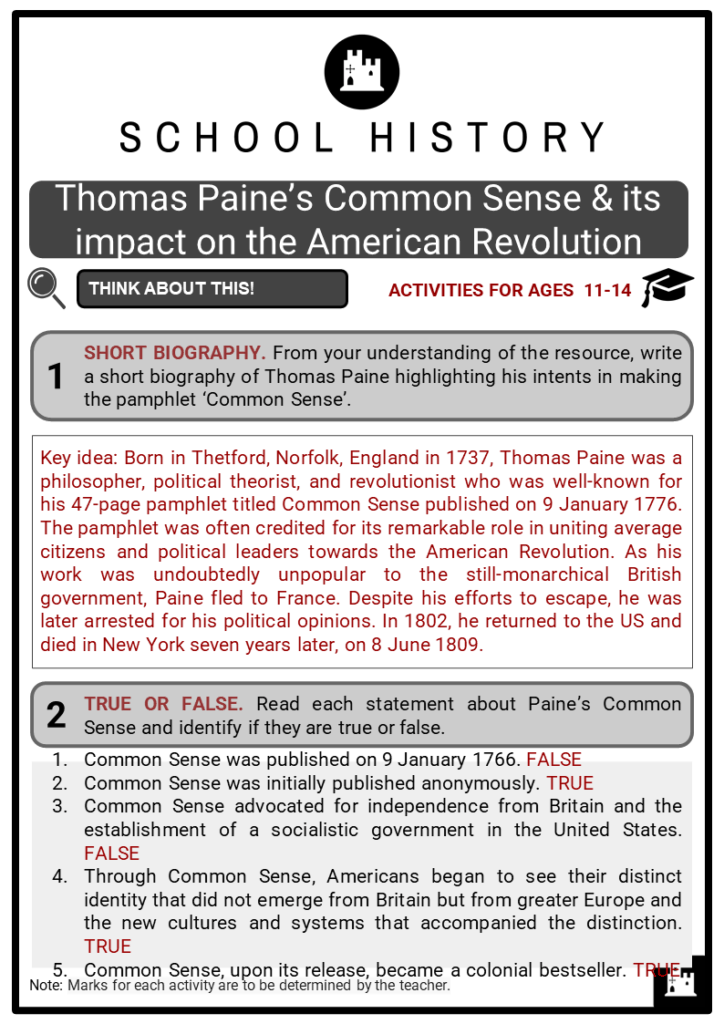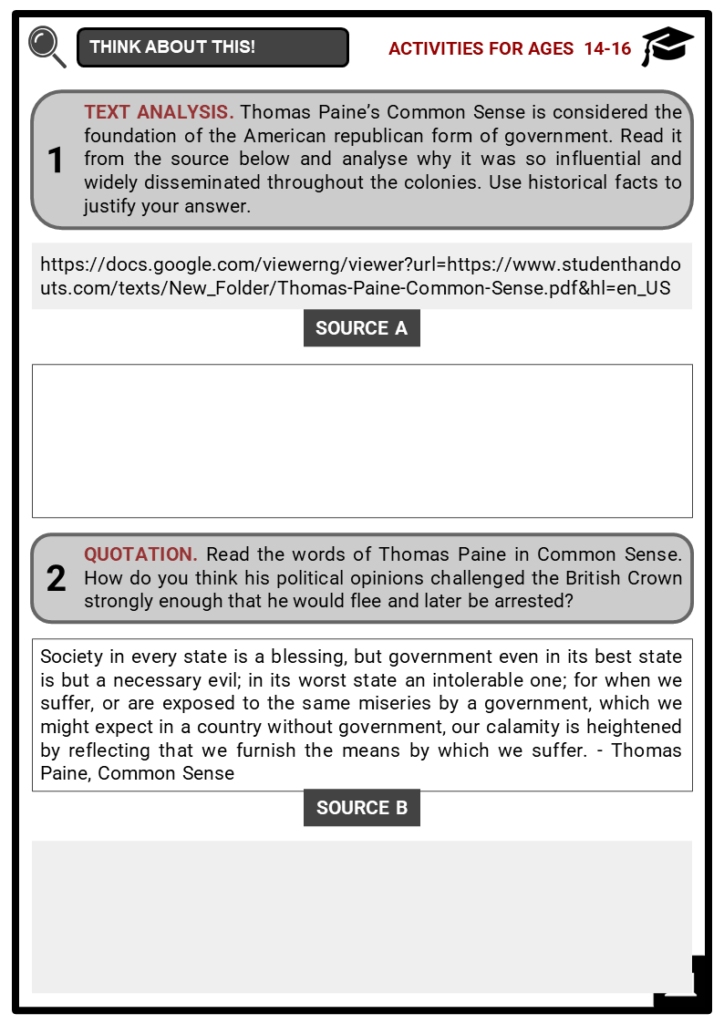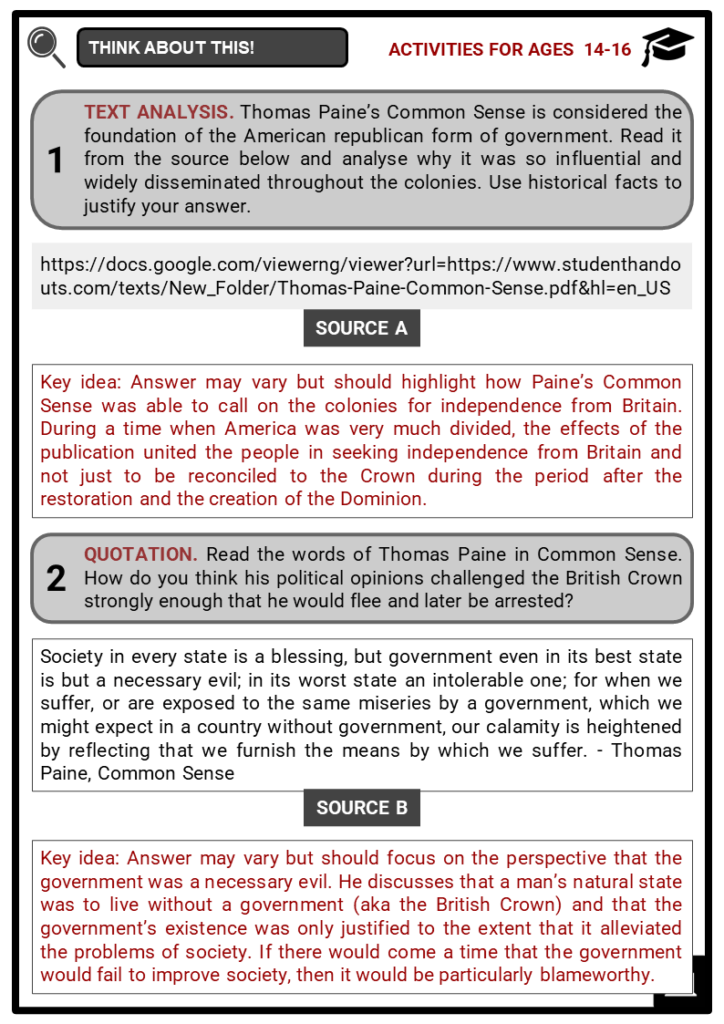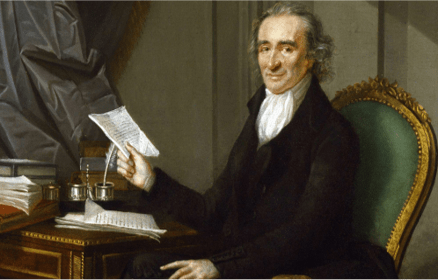Download Thomas Paine’s Common Sense & its impact on the American Revolution Worksheets
Do you want to save dozens of hours in time? Get your evenings and weekends back? Be able to teach Thomas Paine’s Common Sense & its impact on the American Revolution to your students?
Our worksheet bundle includes a fact file and printable worksheets and student activities. Perfect for both the classroom and homeschooling!
Table of Contents
Add a header to begin generating the table of contents
Summary
- Thomas Paine and the creation of Common Sense
- The contents of Common Sense
- Its impact on the American Revolution
- Impact and response towards the publication of Common Sense
Key Facts And Information
Let’s know more about Thomas Paine’s Common Sense!
- Thomas Paine’s Common Sense was written in plain language and applied contemporary examples that captured the minds of the colonists and united them in demanding independence from Britain. It is considered the pretext to the Declaration of Independence and the foundation of the American republican form of government.
- “Europe, and not England, is the parent country of America. This new world hath been the asylum for the persecuted lovers of civil and religious liberty from every part of Europe. Hither they have fled, not from the tender embraces of the mother, but from the cruelty of the monster; and it is so far true of England, that the same tyranny which drove the first emigrants from home pursues their descendants still.” - Thomas Paine 1776
Thomas Paine and the Creation of Common Sense
- Born in Thetford, Norfolk, England in 1737, Thomas Paine was a philosopher, political theorist, and revolutionist. During his teenage years, he worked as a corset maker and later on, a sailor and school teacher, before becoming a prominent pamphleteer. In 1774, he arrived in Philadelphia to support American independence. After two years of continued support, he wrote his 47-page pamphlet called Common Sense.
- Common Sense, specifically published on 9 January 1776, was written in plain and persuasive language, using simple reasoning and examples contemporary to the time that the average American could relate to.
- It was originally published anonymously during a time when most colonists considered themselves Britons. When it was published, it fundamentally changed the colonists’ perspective of Britain as it advocated independence for the American colonies that were under the Crown. Thus, it is often credited for its remarkable role in uniting average citizens and political leaders towards the American Revolution.
- As his work was undoubtedly unpopular to the still-monarchical British government, Paine fled to France. Despite his efforts to escape, he was later arrested for his political opinions. In 1802, he returned to the US and died in New York seven years later, on 8 June 1809.
From Common Sense Towards the American Revolution
- Among the arguments posed by Paine in Common Sense were the following:
- America should be independent from Britain, as the mother colony only cared for its own profit and not the interests of the colonists.
- He urged readers that independence should be immediate, as tension between the American colonies and Britain were out of control. He pointed out that, as a young nation, America had little to lose in the event of war.
- Paine believed that monarchies, as a form of government, violated nature and religion. He emphasised that all people are born equal so no family or person was better than another.
- Paine also emphasised the great possibility to bring America to open trade and better international relations by becoming independent from Britain.
- He discussed how American trade should no longer be limited by British laws, therefore opening up to more trading partners like Spain and France.
- Moreover, America would no longer be stuck in the middle of wars between Britain and its rivals.
- Common Sense advocated for independence from Britain and the establishment of a democratic government in the United States. It was instrumental in shifting the identity of Americans from thinking of themselves as British colonists to citizens of a country with a distinct and unique character from Britain, which then led to the American Revolution.
- It began by distinguishing between government and society by describing theoretical reflections and then using those reflections to build contrasts concerning the colonial relationship between America and the Crown. Society, according to Paine, “is all that which by the unity of all is reasonable”. The government, he suggested, is a necessary evil, whose primary objective is to protect society from its own vices by protecting life, liberty and property.
- Common Sense demonstrated the extent to which America was different from Britain by asking its readers to consider a scenario in which a group of people are placed on an island and cut off from the rest of society. It notes that the people on the Island will form connections with one another and develop for themselves a set of laws that govern them.
- Through this, Americans began to see their distinct identity that did not emerge from Britain but from greater Europe and the new cultures and systems that accompanied the distinction.
- The British system, its constitution and the monarchy, were suggested in Common Sense to be substandard. It contended that all are born equal, and that distinction between the Crown and the subject was unnatural.
- Furthermore, Paine traced the origins of the monarchic systems to the Jews in the Old Testament. Paine demonstrated the sinful origins of monarchy systems and the evils and challenges Britain has faced because of the hereditary system, noting that some kings were incompetent, corrupt, selfish, and led the country to troubled times, including civil wars.
- Common Sense also described the ideals of a representative system of government with each of the colonies being equal to one another. The effects of the publication united the people in seeking independence from Britain and not just to be reconciled to the Crown during the period after the restoration and the creation of the Dominion.
Publication, Impact and Response
- Within the first year of the publication of Common Sense, about 25 editions of it were legally printed. Given the relatively small population of 4 million, about 150,000 copies were sold, which made it a colonial bestseller. Months later, Thomas Jefferson, one of the authors of the Declaration of Independence, used the pamphlet as a template and source of ideas.
- The establishment of a democratic federal government was also part of Paine’s Common Sense. He stated the power of the people to elect its leaders (president and members of Congress). The only structure that was not part of Paine’s original plan was the judicial body and the Constitution.
- The publication was widely read by more than a third of the total population of the 13 colonies and six months later, it became the pretext to the Declaration of Independence. Furthermore, the republican ideas for the formation of a non-hereditary system of government with equality among the colonies became the foundation of the American Constitution.
Image sources:
- https://www.thenation.com/wp-content/uploads/2015/04/thomas_paine_cc_img.jpg?scale=896&compress=80
- http://4.bp.blogspot.com/_XXcaLT43QXc/TLe5iMaqUDI/AAAAAAAABZM/kT9cAsexDKM/s1600/BattleofLongisland.jpg
- http://lasvegastoppicks.com/wp-content/uploads/2015/07/The-Declaration-of-Independence-Thomas-Jefferson.jpg

